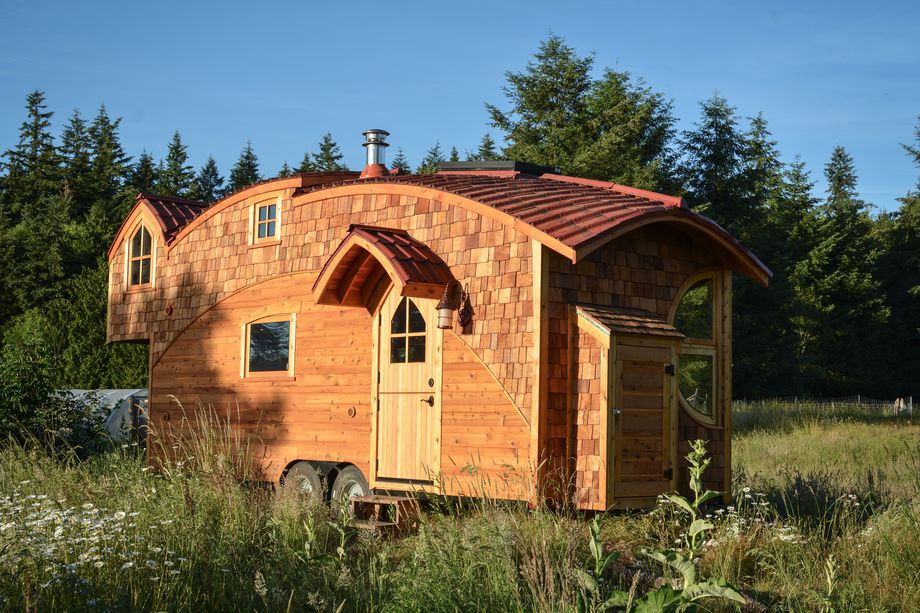The history of the tiny house is, arguably, long. You could trace the tradition of small living back to the first days humans spent in caves, but the modern-day tiny house movement—the act of rejecting more spacious dwellings in favor of pared-down, efficient homes—is easier to track.
Writing extolling the benefits of tiny living emerged in the 1980s, and gained traction in the late 1990s. Over the next few decades, tiny house enthusiasts started design-and-construction companies, wrote blogs and books evangelizing their lifestyle, appeared on television, and generally helped get the word out about the possibilities of living small.
The 2009 housing crisis—and the dramatic rise in foreclosures across the country—only helped push the idea forward. And advocacy work in recent years promises more changes in housing policy and zoning to accommodate tiny houses on a state level.
Curbed spoke with Alexis Stephens, co-founder of Tiny House Expedition, about some of the most significant events of the tiny house movement since Henry David Thoreau published Walden, his ode to life in a 150-square-foot cabin near Walden Pond outside Concord, Massachusetts, in 1854. Stephens points out the main players of the movement, showing how their advocacy led to a mainstream conversation about the benefits of limited square footage.
1854
/cdn.vox-cdn.com/uploads/chorus_asset/file/8873085/Replica_of_Thoreau_s_cabin_near_Walden_Pond_and_his_statue.jpg)
Henry David Thoreau publishes Walden, chronicling his experience over two years, two months, and two days in a 150-square-foot cabin he built near Walden Pond outside Concord, Massachusetts. Unbeknownst to Thoreau, Walden offered a blueprint to tiny house enthusiasts some 150 years later, extolling as it did the merits of modest living within tight quarters.
1973
Authors Lloyd Kahn and Bob Easton release Shelter, a “compendium of organic architecture past and present.” The book details indigenous construction methods and small-house designs found around the world—from Bedouin tents to Togo’s tin-and-thatch houses.
1987
/cdn.vox-cdn.com/uploads/chorus_asset/file/8873211/51SBMTZZQEL._SX361_BO1_204_203_200_.jpg)
Lester Walker publishes the book Tiny Houses: Or How to Get Away From It All, featuring photographs and drawings of projects like a 192-square-foot prefab house and a 56-square-foot shack built on a raft.
1997
Portland, Oregon amends its housing regulations to allow homeowners to build Accessible Dwelling Units (ADUs) by right—meaning they can build an ADU on their property, as long as it meets guidelines, without acquiring a special permit. By removing regulations and restrictions most other cities have surrounding ADUs, and offering financial incentives for homeowners to build them, the city paves the way to becoming one of the most ADU friendly in the country.
1998
Author Sarah Susanka releases her book The Not So Big House, which becomes a bestseller and goes on to spawn a Not So Big franchise.
1999
Jay Shafer, largely credited with jumpstarting the tiny house movement, publishes his first article about the merits of simple living. The same year, he founds the Tumbleweed Tiny House Company in Sonoma, California, the first U.S. company to sell mobile tiny houses.
2002
Jay Shafer, Shay Salomon, Nigel Valdez, and Gregory Paul Johnson found the Small House Society, pooling their knowledge to support more research and development into smaller living spaces.
2007
In February, Shafer appears on The Oprah Winfrey Show, giving a tour of his 96-square-foot home on national television. Oprah also offered tips to viewers on how to maximize space in smaller living quarters.
2007
The first tiny house blog, aptly titled Tiny House Blog, is founded by Kent Griswold. The site provides readers with different design and construction options to downsize into a tiny house or cabin.
2008
The United States subprime mortgage crisis takes hold, with foreclosure filings spiking to more than 81 percent, up 225 percent over 2006. The interest in downsizing and living in more modest homes—including tiny houses—spikes.
2012
Shafer leaves the Tumbleweed Tiny House Company to found Four Lights Houses. Instead of focusing solely on mobile tiny homes, the new company promotes hands-on workshops, books, and the development of tiny house communities. Four Lights goes into discussions with the Sonoma County zoning department about building a tiny house village, which is still in the works.
2013
The Caravan Tiny House Hotel opens in Portland, Oregon, the first of its kind in the United States. The founders, who live in a tiny house legally categorized as an Accessory Dwelling Unit, also begin teaching classes about the design and building process of ADUs.
2014
The FYI channel debuts the reality television program Tiny House Nation. The show follows hosts John Weisbarth and Zack Giffin travelling across America in search of creatively small spaces.
2014
The small town of Spur, in West Texas, proclaims itself the country’s first tiny-house friendly town. The city offers hundreds of vacant lots—alongside a flexible zoning code—for tiny house dwellers. A total of 61 lots have sold since 2014.
2014
HGTV debuts Tiny House Hunters, which follows homebuyers looking to downsize their home. Participants check out three different properties, all under 600 square feet, before deciding whether to join the tiny house movement or go back to a larger space.
2015
The American Tiny House Association is founded as a nonprofit in Florida, with the mission to promote tiny houses as a viable, formally acceptable dwelling option for a variety of people. The organization establishes chapter leaders in many U.S. states.
2015
Zoning legislation is unanimously approved in Rockledge, Florida to allow construction of a tiny homes “pocket” community. The Rockledge Tiny House Community group is established on Facebook with the goal of building a collection of tiny homes on a vacant lot.
2016
Fresno, California, passes new zoning laws that allows for mobile tiny homes to be treated as permanent backyard cottages–previously, mobile units could only serve as temporary lodging. “We are the first city in the nation to actually write into its development code authorization for ‘tiny homes,’” Fresno mayor Ashley Swearingen says at the time.
2016
The International Code Council (ICC) announces that a tiny house specific appendix will be part of the 2018 International Residential Code (IRC), which will allow people to receive a Certificate of Occupancy for their tiny house when built to meet the provisions of the adopted code. A lack of recognition of tiny houses in the IRC was considered a major hindrance to the creation of legal tiny houses across the United States.
2017
Idaho’s state code board votes for an early adoption of the IRC’s tiny house appendix, becoming the first U.S. state to embrace the relaxed code regulations for tiny houses.

